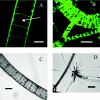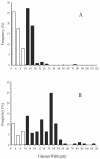Novel, attached, sulfur-oxidizing bacteria at shallow hydrothermal vents possess vacuoles not involved in respiratory nitrate accumulation
- PMID: 15574952
- PMCID: PMC535177
- DOI: 10.1128/AEM.70.12.7487-7496.2004
Novel, attached, sulfur-oxidizing bacteria at shallow hydrothermal vents possess vacuoles not involved in respiratory nitrate accumulation
Abstract
Novel, vacuolate sulfur bacteria occur at shallow hydrothermal vents near White Point, Calif. There, these filaments are attached densely to diverse biotic and abiotic substrates and extend one to several centimeters into the surrounding environment, where they are alternately exposed to sulfidic and oxygenated seawater. Characterizations of native filaments collected from this location indicate that these filaments possess novel morphological and physiological properties compared to all other vacuolate bacteria characterized to date. Attached filaments, ranging in diameter from 4 to 100 microm or more, were composed of cylindrical cells, each containing a thin annulus of sulfur globule-filled cytoplasm surrounding a large central vacuole. A near-complete 16S rRNA gene sequence was obtained and confirmed by fluorescent in situ hybridization to be associated only with filaments having a diameter of 10 microm or more. Phylogenetic analysis indicates that these wider, attached filaments form within the gamma proteobacteria a monophyletic group that includes all previously described vacuolate sulfur bacteria (the genera Beggiatoa, Thioploca, and Thiomargarita) and no nonvacuolate genera. However, unlike for all previously described vacuolate bacteria, repeated measurements of cell lysates from samples collected over 2 years indicate that the attached White Point filaments do not store internal nitrate. It is possible that these vacuoles are involved in transient storage of oxygen or contribute to the relative buoyancy of these filaments.
Figures




References
-
- Abercrombie, M., C. J. Hickman, and M. L. Johnson. 1971. A dictionary of biology, 5th ed., p. 272. Penguin Books Ltd., Harmondsworth, Middlesex, England.
-
- Amann, R. I. 1995. In situ identification of micro-organisms by whole cell hybridization with rRNA-targeted nucleic acid probes, section 3.3.6, p. 1-15. In A. D. L. Akkermans, J. D. van Elsas, and F. J. De Bruijn (ed.), Molecular microbial ecology manual. Kluwer Academic Publishers, Dordrecht, The Netherlands.
-
- Bradford, M. M. 1976. A rapid and sensitive method for the quantitation of microgram quantities of protein utilizing the principle of protein-dye binding. Anal. Biochem. 72:248-254. - PubMed
Publication types
MeSH terms
Substances
Associated data
- Actions
- Actions
LinkOut - more resources
Full Text Sources
Molecular Biology Databases

